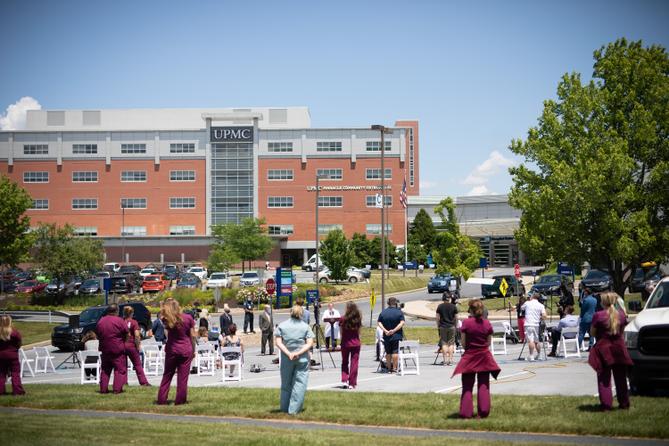Spotlight PA is an independent, nonpartisan newsroom powered by The Philadelphia Inquirer in partnership with the Pittsburgh Post-Gazette and PennLive/Patriot-News. Sign up for our free weekly newsletter.
HARRISBURG — Last week, top officials for the University of Pittsburgh Medical Center — a $21 billion dollar health-care system with tremendous influence over public health policy — made a headline-grabbing claim about the ongoing rise of coronavirus cases in Allegheny County.
In noting the new cases had not led to a major increase in hospitalizations or deaths, Graham Snyder, a physician and medical director of infection prevention, claimed the strain of COVID-19 that UPMC was detecting was less severe than a previous version of the virus.
“You may have heard in the news that there is a dominant global strain, one that seems to transmit easier but is less deadly,” Snyder said at the July 9 press briefing. “That’s the strain we’re detecting. And our data supports those characteristics.”
But a Spotlight PA review of the studies cited by UPMC, as well as interviews with experts in virology and epidemiology, found the assertion is not supported by current research.
“It’s an extraordinary claim, and extraordinary claims require extraordinary evidence,” said Angela Rasmussen, a virologist at Columbia University’s Mailman School of Public Health.
In this case, Rasmussen said, the evidence is simply not there.
When contacted for proof of Snyder’s claim that the virus had become less severe, Allison Hydzik, a spokesperson for UPMC, responded with a link to a study published in the journal Cell.
But the study itself contradicts UPMC’s own takeaways.
Regarding the new strain of the virus, the researchers “did not find evidence” of impact on disease severity, the paper said. There is no evidence COVID-19 has become more — or less — severe.
When Spotlight PA asked for clarity from Hydzik and for further proof of UPMC’s claims, she sent another scientific paper about the mutated strain.
But this second paper stated unequivocally: “Further studies will be necessary to determine the impact of this change on the nature and severity of COVID-19.”
For weeks, scientists have been tangled in a heated debate about the topic.
Part of the issue is that the original study, the one UPMC first provided to Spotlight PA, gained credibility in news media before it had been peer reviewed — the crucial process of having scientists not associated with the research scrutinize its analysis.
And, as it turns out, the research changed substantially during its peer-review process. An article about the process said that after scrutiny, the research concluded scientists “cannot be certain” about whether the new strain is “more transmissible or leads to more severe disease.”
Rasmussen is part of a team now highlighting the limitations of the study.
The study provided important context for epidemiological research, Rasmussen said, but the impact of disease severity is still largely unknown. She said it is “really dangerous” for physicians to leap to sweeping conclusions.
“It’s human nature to want an ‘aha’ explanation,” Rasmussen said, and people are desperate for good news. But if Pennsylvanians hear doctors prematurely declare COVID-19 is less severe, “people will relax their guard.”
UPMC has at times found itself at odds with state and local officials over the coronavirus.
The system in April announced its intention to resume elective surgeries, a major source of revenue, even though a state directive banned such procedures to conserve resources for COVID-19 patients. And as county officials sounded the alarm about a resurgence of cases, UPMC officials urged the public to change its “mindset” and focus instead on severity, though Rasmussen cautioned there is much experts still don’t know about the virus’ long-term effects.
In recent weeks, Allegheny County has seen a marked increase in new COVID-19 infections — from 27 newly confirmed cases on June 21 to a record 210 just days later, according to county data — leading officials to temporarily shut down bars, restaurants, and casinos.
There are many reasons why Pittsburgh, and other regions across the country, might be seeing an increase in COVID-19 cases without a parallel increase in hospitalizations or deaths.
Delays might be the simplest explanation. It takes time for symptoms to develop, to schedule and get the results of a COVID-19 test, and for hospitals to fill up. It also takes time for deaths to occur, then be reported, which skews the real-time view of the disease.
Another explanation might be rising case numbers among young people, who are less likely to immediately suffer serious symptoms, as UPMC’s Snyder said on July 9.
“With the recent shift to younger patients, the most likely explanation for less sickness per patient is that they are younger,” Donald Burke, professor of epidemiology and dean emeritus at the Pitt Graduate School of Public Health, said in an email. “And the most likely explanation for more transmission is the well-documented abandonment of social distancing, especially among young adults.”
But as far as seeing a strain of the virus in Pittsburgh less deadly or less severe than before, Burke said, he is “not aware of any scientific evidence.”
100% ESSENTIAL: Spotlight PA relies on funding from foundations and readers like you who are committed to accountability journalism that gets results. If you value this reporting, please give a gift today at spotlightpa.org/donate.

